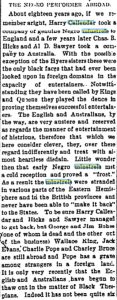“Can any composer ever purge himself entirely of foreign influences?” is the question that David Ewen presents while discussing the birth of the “first coherent musical expression to be produced in America” in a 1933 issue of The Musical Times. It is important to keep in mind that Ewen is exclusively referring to European influences amongst the compositions of young white male composers that make up the New School of American Music, and is implying that American music must be purged of its diverse influences to be considered legitimately American. This question seeks to justify the dismissal of black American jazz contributions while claiming originality, but still reflects the ongoing question: what is American music? Ideals such as autonomy, originality, white purism and “self sufficiency [to] preclude the exotic” are all discussed by Ewen and the new school of composers in New York. One of the founders of this new school, Aaron Copland, claimed early in his career that “jazz-idiom was the native musical tongue of his country,” but later digressed and recognized that “it is certainly not an interpretation of all America.” There is some truth in this statement, but in the search for what constitutes “indigenous” (word choice by Ewen) American music, neither Ewen nor Copland in 1933 propose the envelopment of Native American or Latin American influences in the search to define a holistic American musical identity, perpetuating the ethnocentric discussion of who is encompassed in American music.
Attached below is Louis Gruenberg’s, “The Daniel Jazz” which Ewen describes as being successful in producing “an original musical tongue such as we have not heard in the music of any other composer.” Ewen also describes moments [in the composition] of the volcanic and savage passion so characteristic of the negro,” which I find to be so interestingly juxtaposed with claims of originality from a white male composer. This piece reflects the pertinence of black american jazz influence that white composers took on as “originality” throughout the 20th century.
(Throughout this post I tried to prioritize quoting the language that was used throughout Ewen’s feature, because I think it contributes to the sense of white purism that is infused in his discussion of what he claims to be musical innovation.)
David Ewen. “The New School of American Music.” The Musical Times 74, no. 1088 (1933): 881–83. https://doi.org/10.2307/918504.

